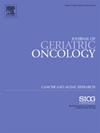Real-world effectiveness and cardiovascular safety of abiraterone versus enzalutamide amongst older patients diagnosed with metastatic castration-resistant prostate cancer
IF 3
3区 医学
Q3 GERIATRICS & GERONTOLOGY
引用次数: 0
Abstract
Introduction
Abiraterone and enzalutamide are both approved in the United States for the treatment of metastatic castration-resistant prostate cancer (mCRPC). The objective of this study was to compare the real-world effectiveness and cardiovascular safety of these agents, drawing from a cohort of older adult patients diagnosed with mCRPC.
Materials and methods
The Surveillance, Epidemiology, and End Results-Medicare database was used to conduct an observational study comparing three-year overall survival and one-year risk of major adverse cardiovascular events (MACE) between initiators of abiraterone or enzalutamide between September 2012 and June 2017. Inverse-probability-of-treatment weighting was used to balance measured confounders. MACE was defined as a hospitalization for myocardial infarction, heart failure, or ischemic event (stroke or transient attack). Results were additionally stratified by levels of a claims frailty index (robust, prefrail, frail) and the presence of baseline cardiovascular comorbidities.
Results
The study population consisted of 4622 male adults 66 years of age and older diagnosed with mCRPC, of which 2430 initiated abiraterone and 2192 enzalutamide. The adjusted three-year overall survival was lower in patients initiating abiraterone (27.9 %) than enzalutamide (31.5 %) (adjusted survival difference [aSD] = −3.6 %, 95 % CI: −6.2 %, −0.9 %). In frailty-stratified analysis, no survival difference was found for the robust (aSD = 0.6 %, 95 % CI: −5.0 %, 6.3 %) or frail (aSD = −1.2 %, 95 % CI: −6.1 %, 3.7 %) subgroups, but there was lower survival with abiraterone for the prefrail group (aSD = −5.9 %, 95 % CI: −9.6, −2.3). The adjusted one-year risk of MACE was higher in abiraterone initiators (5.5 %) than enzalutamide initiators (3.6 %) (adjusted risk difference [aRD] = 1.8 %, 95 % CI: 0.6 %, 3.1 %); the increase was significant in the frail (aRD = 4.8 %, 95 % CI = 1.4 %, 8.3 %) and pre-frail subgroups (aRD =1.9 %, 95 % CI: 0.1 %, 3.6 %) but not the robust subgroup (aRD = −0.3 %, 95 % CI: −1.8 %, 1.2 %).
Discussion
The three-year survival of abiraterone initiators was slightly lower than that of enzalutamide initiators, though the agents showed similar survival for patients with robust fitness. A one-year increase in MACE risk was observed in abiraterone initiators, especially amongst frail individuals, highlighting the importance of assessing frailty during therapy selection.
阿比特龙与恩杂鲁胺在老年转移性去势抵抗性前列腺癌患者中的实际有效性和心血管安全性
在美国,阿比特龙和恩杂鲁胺都被批准用于治疗转移性去势抵抗性前列腺癌(mCRPC)。本研究的目的是从诊断为mCRPC的老年成年患者队列中比较这些药物的实际有效性和心血管安全性。材料和方法:使用监测、流行病学和最终结果- medicare数据库进行一项观察性研究,比较2012年9月至2017年6月期间阿比特龙或恩杂鲁胺启动者的3年总生存率和1年主要不良心血管事件风险(MACE)。使用逆处理概率加权来平衡测量的混杂因素。MACE被定义为因心肌梗死、心力衰竭或缺血性事件(中风或短暂性发作)住院。结果还根据声称的虚弱指数(强壮、虚弱、虚弱)和基线心血管合并症的存在程度进行分层。结果:研究人群包括4622名66岁及以上诊断为mCRPC的男性成年人,其中2430人开始使用阿比特龙,2192人使用恩杂鲁胺。起始治疗阿比特龙的患者调整后三年总生存率(27.9%)低于起始治疗恩杂鲁胺的患者(31.5%)(调整后生存差[aSD] = - 3.6%, 95% CI: - 6.2%, - 0.9%)。在衰弱分层分析中,在健壮亚组(aSD = 0.6%, 95% CI: - 5.0%, 6.3%)和虚弱亚组(aSD = - 1.2%, 95% CI: - 6.1%, 3.7%)中没有发现生存差异,但在虚弱亚组(aSD = - 5.9%, 95% CI: -9.6, -2.3)中阿比特龙的生存较低。阿比特龙起始剂的1年MACE调整风险(5.5%)高于恩杂鲁胺起始剂(3.6%)(调整风险差[aRD] = 1.8%, 95% CI: 0.6%, 3.1%);在虚弱亚组(aRD = 4.8%, 95% CI = 1.4%, 8.3%)和虚弱前亚组(aRD = 1.9%, 95% CI: 0.1%, 3.6%)中增加显著,但在健壮亚组中没有(aRD = - 0.3%, 95% CI: - 1.8%, 1.2%)。讨论:阿比特龙启动剂的三年生存率略低于恩杂鲁胺启动剂,尽管两种药物在健康状况良好的患者中显示出相似的生存率。在阿比特龙启动者中观察到一年的MACE风险增加,特别是在虚弱的个体中,强调了在治疗选择中评估虚弱的重要性。
本文章由计算机程序翻译,如有差异,请以英文原文为准。
求助全文
约1分钟内获得全文
求助全文
来源期刊

Journal of geriatric oncology
ONCOLOGY-GERIATRICS & GERONTOLOGY
CiteScore
5.30
自引率
10.00%
发文量
379
审稿时长
80 days
期刊介绍:
The Journal of Geriatric Oncology is an international, multidisciplinary journal which is focused on advancing research in the treatment and survivorship issues of older adults with cancer, as well as literature relevant to education and policy development in geriatric oncology.
The journal welcomes the submission of manuscripts in the following categories:
• Original research articles
• Review articles
• Clinical trials
• Education and training articles
• Short communications
• Perspectives
• Meeting reports
• Letters to the Editor.
 求助内容:
求助内容: 应助结果提醒方式:
应助结果提醒方式:


